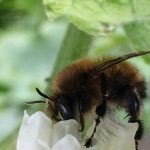Flowers for Early Pollinators
Flowers for Early Pollinators

By Harriet English
Early Spring, a truly magical and favourite time of year. Winter is still loitering around in the background, like a tiresome party guest, occasionally making its presence felt, but Spring is on the threshold, waiting to enter. There’s no going back now
Early Spring flowers and shrubs are absolutely vital to all those insects waking up from hibernation. Bumblebees, solitary bees, hoverflies, butterflies and many other pollinators emerge when the weather warms up, and this can be any time from February, but then pollen and nectar can be hard to come by. These vital pollinators need to be fed quickly to replenish energy lost during the winter sleep
When wasp and bumblebee queens emerge from hibernation, they need to gather pollen and nectar to start their new colonies. Having a good selection of these plants in a garden, whatever the size or location, can really help these important insects. The key is to choose the right plants. Opt for plants with nectar-rich, single flowers rather than double blooms, which are harder for pollinators to access and may not contain any nectar or pollen. Both native and non-native plants can be valuable sources of nectar and pollen:
Crocus – purple flowered varieties are the most popular with pollinators
Snowdrops
Sweet Violet
Lesser Celandine
Hellebores – (Christmas/Lenten Rose)
Grape Hyacinth
English Bluebell
Flowering Currant
Comfrey/Bugle
Winter Aconite
Wood Anemone
Dandelion
There are some species of butterfly that will be migrating back to the UK from warmer climes, so will need plenty of nectar after their long trip, and some bumblebee nests remain active throughout the winter
For more information check out Wildlife Trusts, Plantlife and Bumblebee Conservation